The most expensive helmets. Part two. Helmet Hallathon
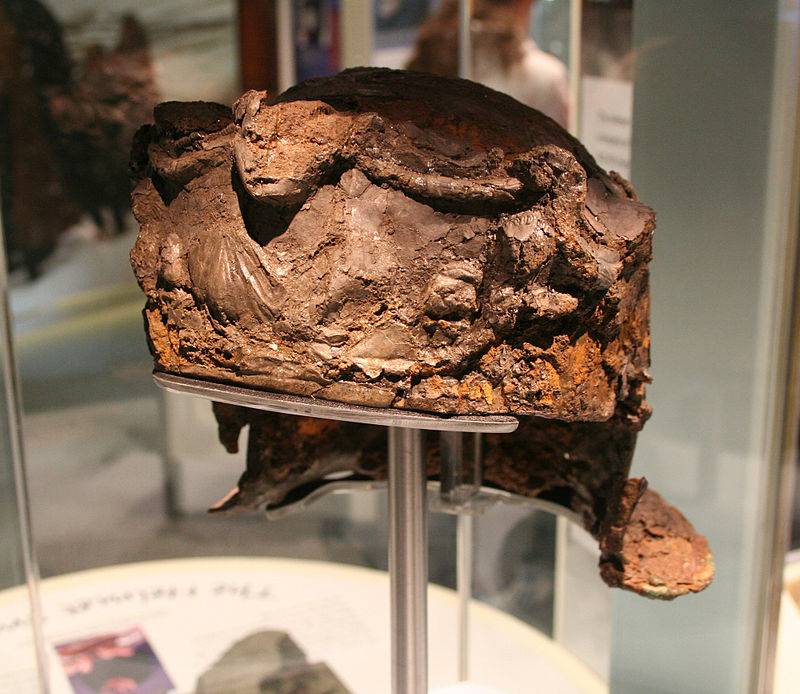
Helmet from Hallaton. Front view.
The helmet was found broken into thousands of pieces and besides, it was heavily damaged by rust. But despite this, the helmet is an excellent example of Roman blacksmith skill. It is covered with silver and decorated with chased images of goddesses and horses. It is believed that he was worn by the Roman cavalry of auxiliary units both at parades and, possibly, in battle. The fact that he was found next to thousands of coins of Roman time suggests that he could belong to a local who fought with the Romans during the Roman conquest of Britain.
Roman cavalrymen of auxiliary units also used such helmets in gymnastics hippie competitions. To participate in them, riders put on luxurious clothes, armor and helmets, decorated with plumes of ostrich feathers, and recreated on the field historical and legendary battles. It is known, for example, that masks on helmets could have female features - and then it was a team of Amazons, and male ones - copying the image of Alexander the Great.
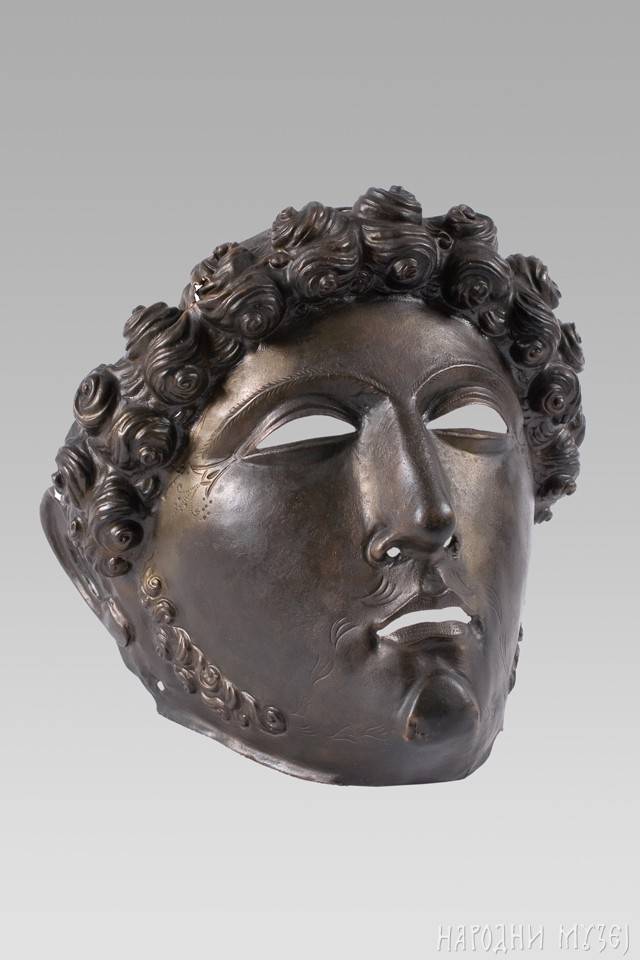
Helmet-mask with the face of Alexander of Macedon, bronze. Smederevo, II century AD (Folk Museum, Belgrade)
The helmet consists of three parts and is made of sheet iron. Today it is the only Roman helmet ever found in Britain that has retained most of its silver coating. Initially, the helmet had two patches attached to it through the holes near the ears.
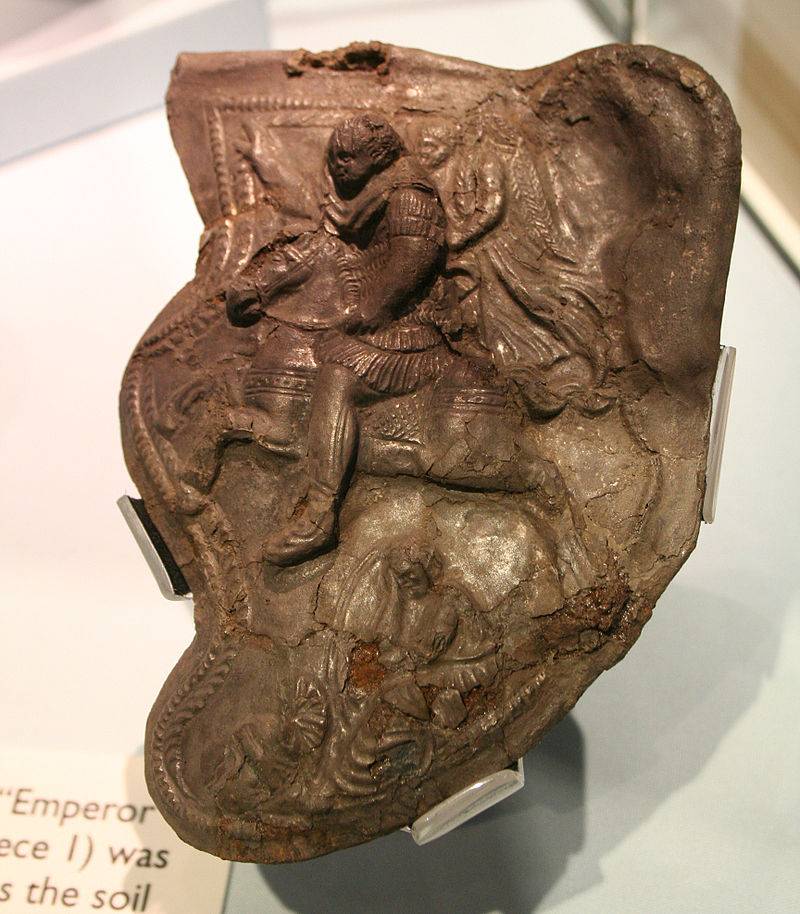
The Emperor lapel (No. 1), depicting the Roman emperor, crowned with the figure of the goddess of Victory, and trampling on the barbarian with the hooves of his horse.
As is the case with other Roman cavalry helmets, the “Hallathon helmet” is very richly decorated. It looks like a helmet, found in Hunten-Ward in Germany, which, like the Hallanton one, is made of silver-gilded iron with a crown in the shape of a wreath, a central figure above the eyebrows and a garland of flowers on our warrior. The bowl of the English helmet is also decorated with laurel wreaths, and in the center of the crown is the (now badly damaged) bust of a woman surrounded by lions. Perhaps she was an empress or goddess. The iconography resembles the image of Cybele, the Great Mother, whose image was used in the era of Emperor Augustus.
Interestingly, in the helmet's helmet, six patches of the head and still splintered remains of the seventh were found, although only two were needed. Hinges were also found, as were the pins of one of the cheek pads. It is not clear why so much was done for one helmet. Is it really "spare parts" in case of damage? Or they were changed depending on ... what? It should be noted that the preserved cheek pads are structurally very complex. Five of them show equestrian scenes; one depicts the triumph of the Roman emperor. The treacherous barbarian is depicted below and trampled down by the hooves of his horse. Another less well-preserved faceplate depicts a figure with a large cornucopia, a Roman helmet and a shield.
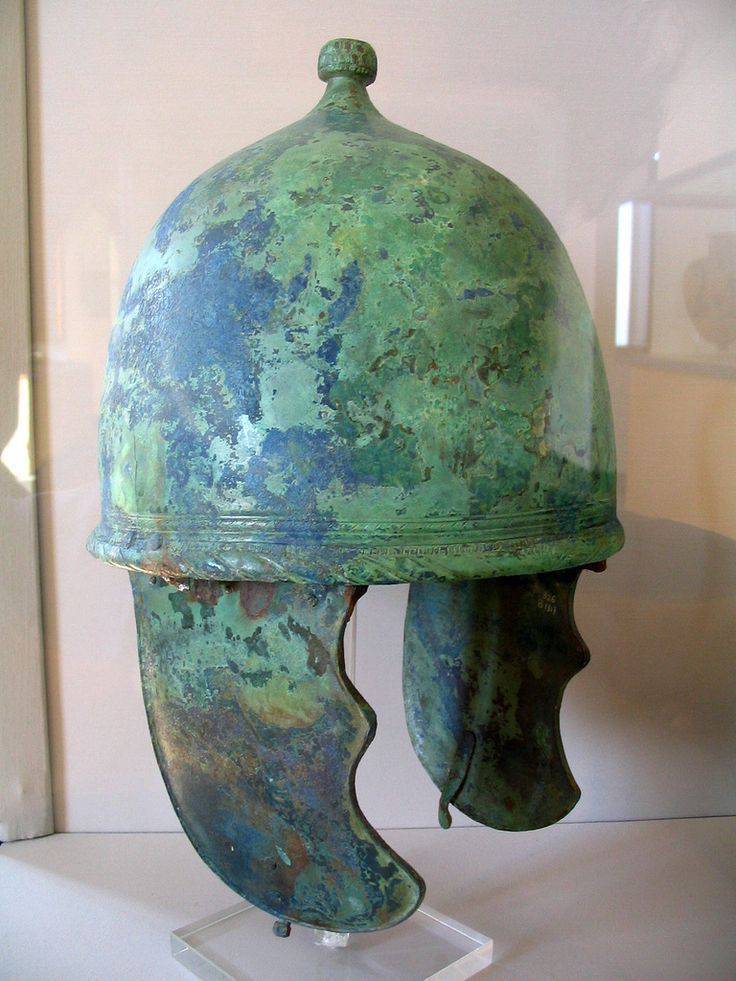
Helmet type Montefortino (350 - 300 years. BC). (Museum of National Archeology in Perugia. Italy)
The helmet was found along with 5296 coins of the Roman era, mainly related to 30-50. AD, and this is the largest collection of coins of this time ever found in the UK. They were buried on the spot ... "the slaughter of animals"; in the same place where about 7000 fragments of their bones were found, 97 percent of which were pork, on top of a hill surrounded by a ditch and palisade. That is, it was clearly some kind of altar, where pigs were brought from all around and where they were killed. Either they were killed first, the meat was eaten, and the bones were brought here. More precisely today you will not tell. In any case, archaeologists believe that finding a helmet in such a place is quite unusual. Taking into account its possible dating, it can be argued that today it is one of the earliest Roman helmets ever found on the territory of England. Other helmets, like the same “Gisborough helmet” or the “Crosby Garrett helmet” already known to us, like the “Newsted helmet”, belong to a later time. Various proposals have been made as to why the helmet was in Hallanton; perhaps it belonged to a British who served in the Roman cavalry, perhaps it was a diplomatic gift from the Romans to some local leader, or he, on the contrary, was captured as a trophy in the war and then sacrificed to local deities. According to Dr. Jeremy Hill of the British Museum, the first explanation is most likely: "Most likely there was a situation when local warriors fought on the side of the Romans."
"Capture Decibal." The scene on the column of Trajan in Rome. Roman helmets with a carrying ring, loric segmented plate armor and chain mail with a notched hem - Lorica gamata are clearly visible.
This view is based on the fact that the Romans used to recruit cavalry from the aborigines, rightly believing that local horses and people are most suitable for local conditions. They played the role of intelligence and lookout, but in the battles the Roman cavalry played a minor role. The fact is that the height of the Roman horses were small. In addition, the Romans rode them bareback and stirrups. The Nimidian cavalry did not even have a reins. Like the Indians, the Numidians ruled the horse with the shenkels and only had a belt around the horse’s neck, which they could grasp in principle. And that's it! On the column of Trajan, where the Numidian horsemen are depicted, their horses do not have any other harness. Weapon Numidians served two darts, which they threw at full gallop, which increased their flight range and impact force, and the falcata sword.
Bronze snaffle from a treasure in Polden Hill, Somerset.
As for the equipment of the auxiliary cavalry of the Roman troops in the lands of Britain, its soldiers had a helmet, a coat of mail, an oval shield, a Spatu sword and a spear of gastu with a tip in the form of a bay leaf. Again, when attacking, spears threw and ... returned to the camp for new ones. That is why, by the way, hippie gymnasium games were so popular at that time: it required the ability to accurately throw spears and darts at a gallop, and ... in general, nothing more! Luxurious scenes from the movie "Dacs", where the Roman cavalry galloping chops his opponents with swords, is nothing more than a colorful picture that has nothing in common with reality.
The tactical unit in the cavalry served as ala (in Latin - “wing”), a unit numbering 512 warriors and divided into smaller units - Turma, consisting of 32 cavalrymen each. Compare this with the number of the legion, which in the era of the Empire consisted of 6000 soldiers, and we get ... the importance of cavalry in the Roman army. And the reason was simple: the Roman riders did not know the stirrups, although they knew the spurs. However, for some reason, the spur was worn on one leg only, spurs were not paired.
The rider of the Roman cavalry in equipment for hippies gymnasium. The tips of the darts were wooden. But when they got into the open parts of the body, injuries were inevitable, so helmets must have masks. Fig. A. Shepsa.
The restored helmet was presented to the public in January 2012. The Leicester County Council was able to raise £ 1million to 1 in order to buy all the treasure and pay to save the helmet with donations from the Lottery Fund of charities. The helmet was rated at 300 000 pounds. In accordance with the provisions of the Treasure Act, Ken Wallace and the landowner, on whose land the helmet was found, were paid in 150 000 pounds sterling to each. After that, he went on display at Market Harbour, nine miles from where the treasure was found, along with other artifacts found in Hallathon.
Helmet in the museum.
It is believed that the helmet looks lush, but decorated extremely tasteless, which reflects the decadence of the Roman culture of the era of the empire. However, if it was made for Aboriginal people, then this is not surprising. Tasteless, but beautiful. Glitters, many figures, silver, gold, what else does a person who aspires to adopt the high standards of the level of life of such successful conquerors ?!
To be continued ...
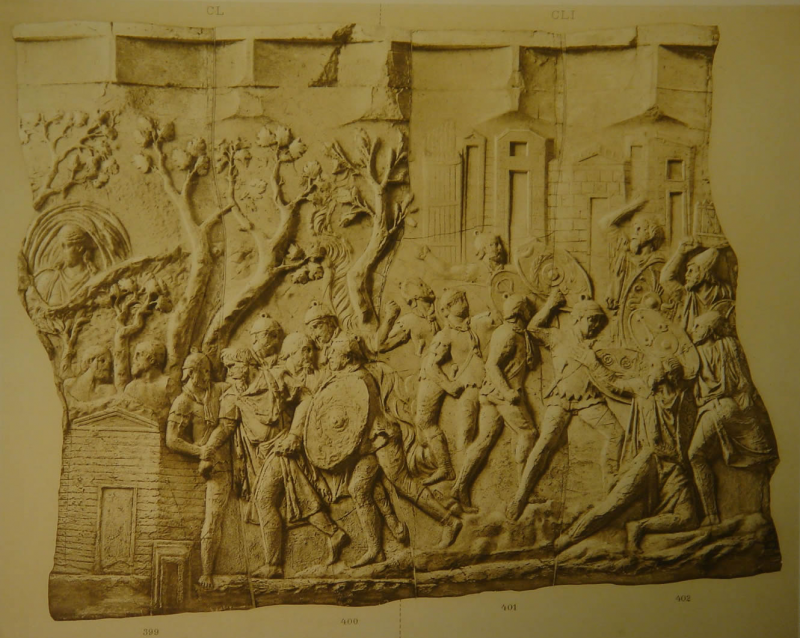

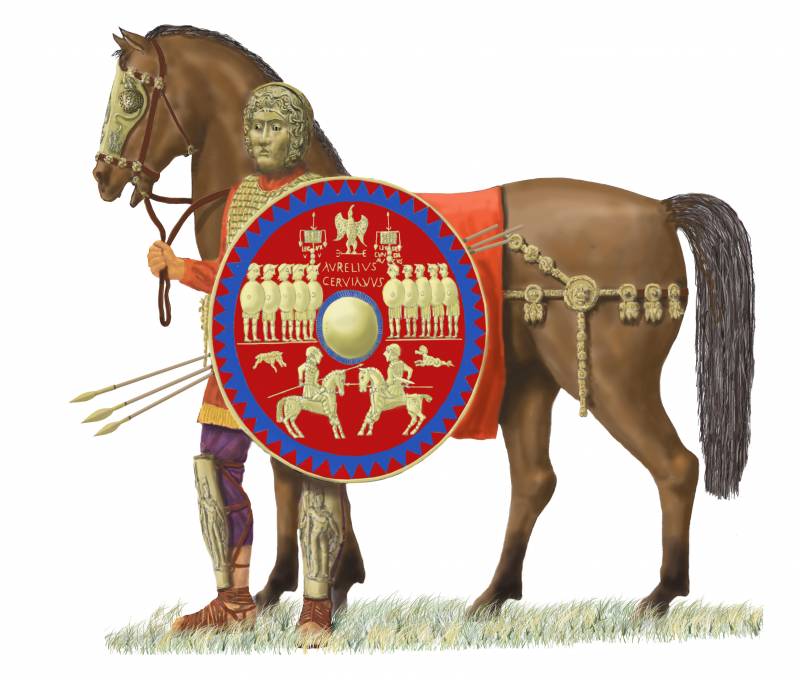
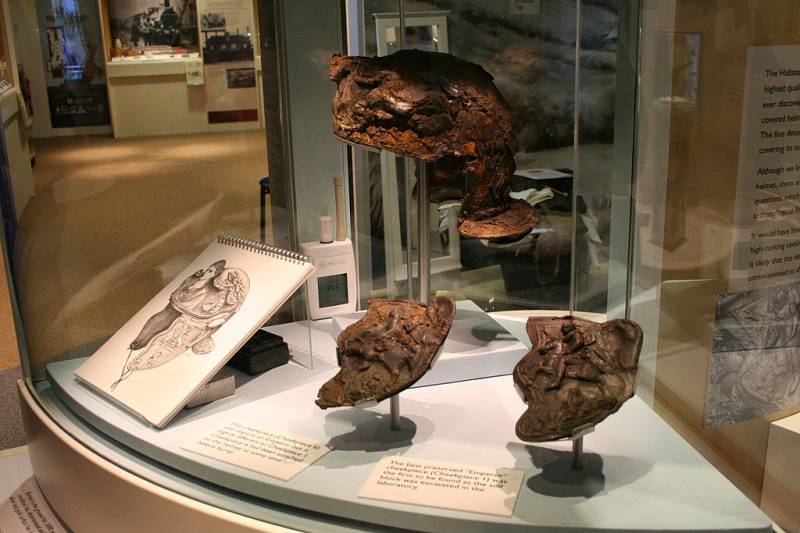
Information